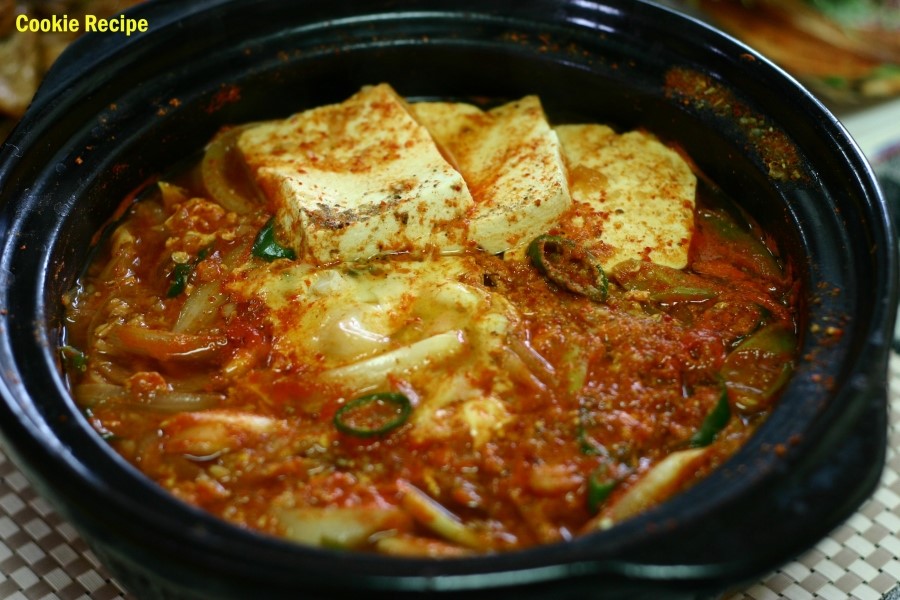Spicy Fish Stew (Maeuntang) and Savory Soy-Glazed Chicken
A Hearty Recipe for Spicy Fish Stew Using Leftover Fish and Soy-Glazed Chicken

Enjoy a comforting meal with a refreshing and spicy fish stew made from leftover fish, alongside a savory and hearty soy-glazed chicken. This recipe offers a delicious way to utilize ingredients and create a fulfilling feast.
Maeuntang (Spicy Fish Stew) Ingredients- Fish bones or leftover fish fillets
- Radish, 4 slices (cut into large pieces)
- Water
- Crown daisy (Ggaennip), a handful
- Tofu, 1/2 block
- Egg, 1
- Onion, 1/2 (sliced)
- Green onion, 1 stalk (cut diagonally)
- Cheongyang chili peppers, 2 (sliced diagonally)
Soy-Glazed Chicken Ingredients- Chicken pieces, 1 whole chicken
- Carrot, 1/3 (cut into bite-sized pieces)
- Onion, 1/2 (cut into bite-sized pieces)
- Green onion, 2 stalks (cut into bite-sized pieces)
- Cheongyang chili peppers, 2 (sliced diagonally)
- Cooking oil, 3 tablespoons
Maeuntang Seasoning- Gochugaru (Korean chili flakes), 1 tablespoon
- Minced garlic, 1.5 tablespoons
- Gochujang (Korean chili paste), 0.5 tablespoon
- Soy sauce, 2 tablespoons
- Black pepper, a pinch
- Sichuan pepper powder (Sancho powder), 0.5 tablespoon (optional, for enhanced flavor)
Soy-Glazed Chicken Seasoning- Sesame oil, 1 tablespoon
- Soy sauce, 5 tablespoons
- Yoridang (cooking syrup), 3 tablespoons (or corn syrup/sugar)
- Minced garlic, 1.5 tablespoons
- Black pepper, a pinch
- Chicken pieces, 1 whole chicken
- Carrot, 1/3 (cut into bite-sized pieces)
- Onion, 1/2 (cut into bite-sized pieces)
- Green onion, 2 stalks (cut into bite-sized pieces)
- Cheongyang chili peppers, 2 (sliced diagonally)
- Cooking oil, 3 tablespoons
Maeuntang Seasoning- Gochugaru (Korean chili flakes), 1 tablespoon
- Minced garlic, 1.5 tablespoons
- Gochujang (Korean chili paste), 0.5 tablespoon
- Soy sauce, 2 tablespoons
- Black pepper, a pinch
- Sichuan pepper powder (Sancho powder), 0.5 tablespoon (optional, for enhanced flavor)
Soy-Glazed Chicken Seasoning- Sesame oil, 1 tablespoon
- Soy sauce, 5 tablespoons
- Yoridang (cooking syrup), 3 tablespoons (or corn syrup/sugar)
- Minced garlic, 1.5 tablespoons
- Black pepper, a pinch
- Sesame oil, 1 tablespoon
- Soy sauce, 5 tablespoons
- Yoridang (cooking syrup), 3 tablespoons (or corn syrup/sugar)
- Minced garlic, 1.5 tablespoons
- Black pepper, a pinch
Cooking Instructions
Step 1
Pour a generous amount of water into a ttukbaegi (earthenware pot) or a regular pot and bring it to a boil. Once boiling, add the fish bones or leftover fish fillets, and the roughly chopped radish. Let it boil vigorously over high heat for about 5 minutes. As it boils, skim off any foam that rises to the surface to ensure a clear broth. This step is crucial for a cleaner taste.

Step 2
After the broth has simmered sufficiently, add 1.5 tablespoons of minced garlic. If your fish or fish bones were frozen and you’re concerned about a fishy odor, adding a little extra garlic at this stage can help neutralize it. Next, stir in 1 tablespoon of gochugaru (Korean chili flakes) and 0.5 tablespoon of gochujang (Korean chili paste), and bring it back to a simmer. If you prefer a richer and spicier broth, feel free to add another 0.5 tablespoon of gochujang. For a refreshing taste, or if you detect a slight fishiness from the broth, adding gochujang along with 0.5 tablespoon of sancho powder (Sichuan pepper powder) will significantly enhance the depth of flavor. While sancho powder is commonly used in freshwater fish stews, it adds a wonderful aromatic complexity to any fish maeuntang.

Step 3
While the stew is simmering, add the sliced onion, diagonally sliced green onion, and Cheongyang chili peppers to infuse the broth with their aroma. Now, add 2 tablespoons of soy sauce and adjust the seasoning to your preference. Once the seasoning is balanced, carefully arrange the sliced tofu around the edges of the pot. Sprinkle a little more sancho powder on top for an extra layer of flavor. Just before turning off the heat, crack an egg directly into the stew. After the stew is fully cooked, garnish generously with fresh crown daisy for a beautiful presentation and a final touch of herbaceous freshness.

Step 4
Let’s start preparing the soy-glazed chicken. Thoroughly wash the chicken pieces and pat them dry. Heat 3 tablespoons of cooking oil and 1 tablespoon of sesame oil in a frying pan or pot. Add the chicken pieces and stir-fry them. You don’t need to cook them all the way through at this stage; just brown the surfaces slightly until about 10% cooked.

Step 5
Once the chicken is about 10% cooked, add 5 tablespoons of soy sauce, 1.5 tablespoons of minced garlic, and 3 tablespoons of yoridang (cooking syrup). Stir well to coat the chicken. Continue to stir-fry until the glaze coats the chicken and its color deepens slightly, about 30% cooked.

Step 6
Now, add the prepared onion, green onion, carrots, and Cheongyang chili peppers. Stir-fry them together with the chicken until the vegetables are slightly softened, about 50% cooked. You’ll notice delicious juices starting to release from the chicken during this step. Cover the pot with a lid, reduce the heat to low, and let it simmer for about 5 minutes, stirring and flipping the chicken occasionally. It’s important to taste and adjust the seasoning during this stage; if it’s not salty or sweet enough, add more soy sauce, yoridang, or minced garlic to suit your palate. Recipes are guidelines, and ingredients can vary, so tasting and adjusting is key to achieving your perfect flavor.

Step 7
Continue to simmer until the chicken is fully cooked and the glaze has thickened and coated the pieces beautifully. Once everything is well-cooked and fragrant, transfer the soy-glazed chicken to a serving plate and enjoy your delicious creation!




